
QUARTZ MOUNTAIN ART COLLECTION
Welcome to Quartz Mountain, home of the Oklahoma Arts Institute and the Quartz Mountain Art Collection. Rich in history and natural beauty, Quartz Mountain has transitioned from being a Native American ceremonial site to the region’s artistic epicenter, inspiring artists from across the United States and incubating Oklahoma’s homegrown talent. The Quartz Mountain Art Collection tells that story.
About the Oklahoma Arts Institute
The Oklahoma Arts Institute (OAI) is a private, nonprofit organization founded in 1977 with a mission to provide exceptional multidisciplinary arts experiences that develop individual talent and inspire a lifelong passion for the arts. Each year, OAI recruits internationally renowned artists to Quartz Mountain to teach high school students and adult artists in a series of continuing education workshops in the literary, visual and performing arts. Faculty have included winners of the Pulitzer Prize and the Academy, Grammy, Emmy, and Tony Awards. The Quartz Mountain Art Collection is comprised of works created by OAI faculty artists and students and serves as a visual record of the history of Quartz Mountain and OAI. The collection is owned by OAI and is on permanent loan to the state of Oklahoma for exhibition at the Quartz Mountain Arts and Conference Center.
Quartz Mountain History
Archeological evidence suggests Paleo-Indian people hunted woolly mammoth near Quartz Mountain between 11,000 and 20,000 years ago. Excavations at the Cooperton site near Kiowa County provide the earliest known evidence of people in the state of Oklahoma.
Spain and France traded Quartz Mountain several times before the U.S. bought the area as part of the Louisiana Purchase in 1803. Quartz Mountain was ceremonial grounds for the Kiowa, Comanche, Wichita, Apache, and Caddo tribes, who occupied the area until the late 1880s.
The Gold Rush brought eager prospectors to Quartz Mountain in 1887. Although the U.S. Army was charged with regulating Indian Territory, and a treaty was issued prohibiting mining, prospectors destroyed many Native American ranches and fields before the military finally regained control of the area. The Quartz Mountain area was opened to white settlement in 1901.
In 1927, the tiny town of Lugert was flooded to create a municipal water supply for Altus, now known as Lake Altus-Lugert. The lake and surrounding mountains caught the attention of the National Park Service, which began developing Quartz Mountain during the Great Depression with the help of the Civilian Conservation Corps. In 1937, Quartz Mountain officially became a state park.
Begin your tour of the art collection just inside the entrance to the lodge lobby.
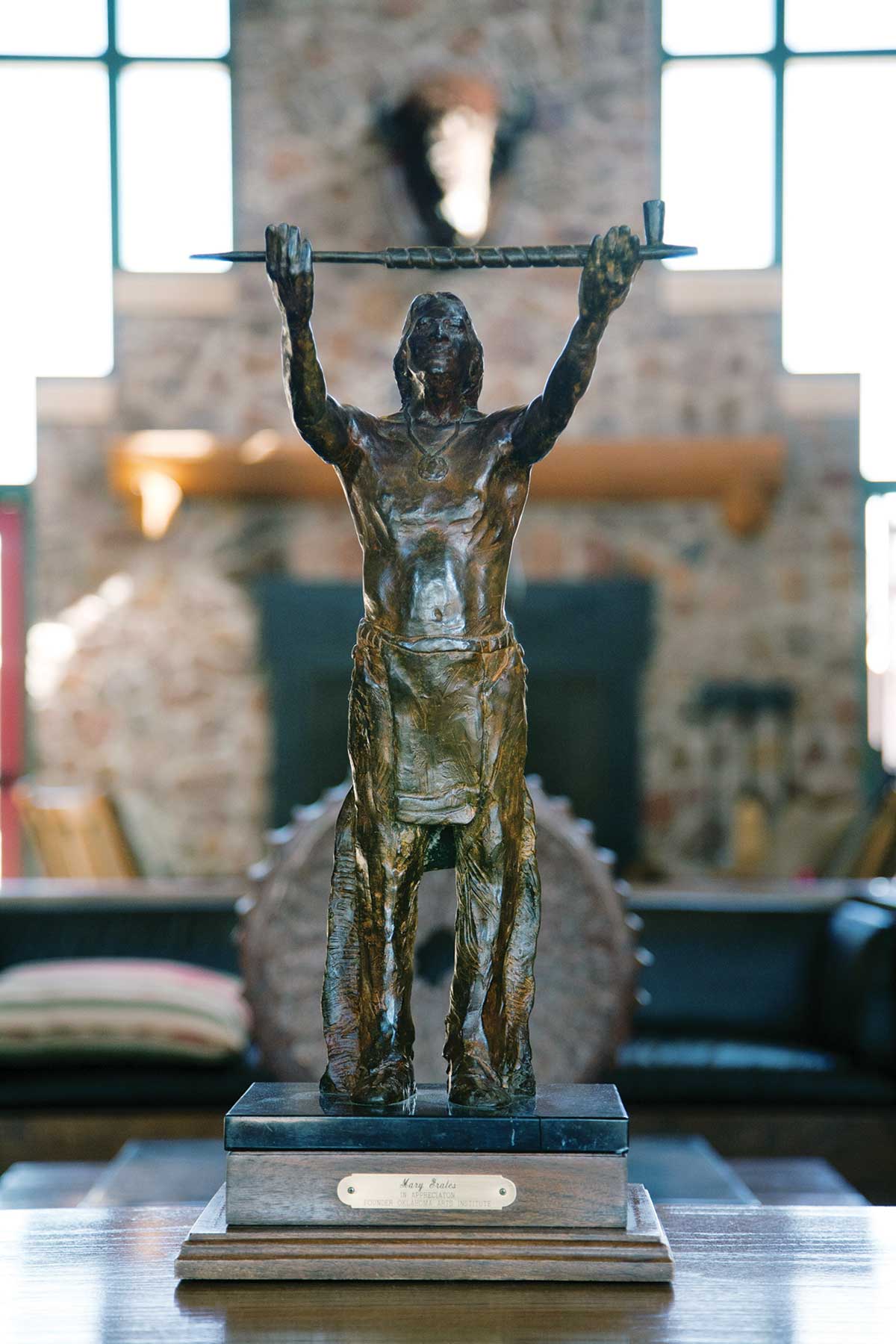
1. Mike Larsen
Blessing
2001
Bronze
Oklahoma artist Mike Larsen is a member of the Chickasaw Nation and served as a faculty artist for OAI in 1997. In this work, Larsen presents the viewer with a Native American figure who stands with arms raised in blessing.
Adorning the walls of the lodge lobby are a series of murals created by Larsen that depict the past, present, and future of Quartz Mountain. The four murals along the west wall constitute Quartz Mountain: Sacred Ground—The Past, each portraying a significant element of Kiowa lore. On the opposite wall, the four murals comprising Quartz Mountain: Sacred Ground—The Future illustrate the present and the future of Quartz Mountain as a center for the study of the arts with depictions of the Oklahoma Arts Institute’s faculty artists and students. For this series, Larsen immersed himself in the history of the Kiowa, consulting tribal elders and traveling to such locales as Rainy Mountain and the headwaters of the Yellowstone River to help ensure the accuracy of his depictions.
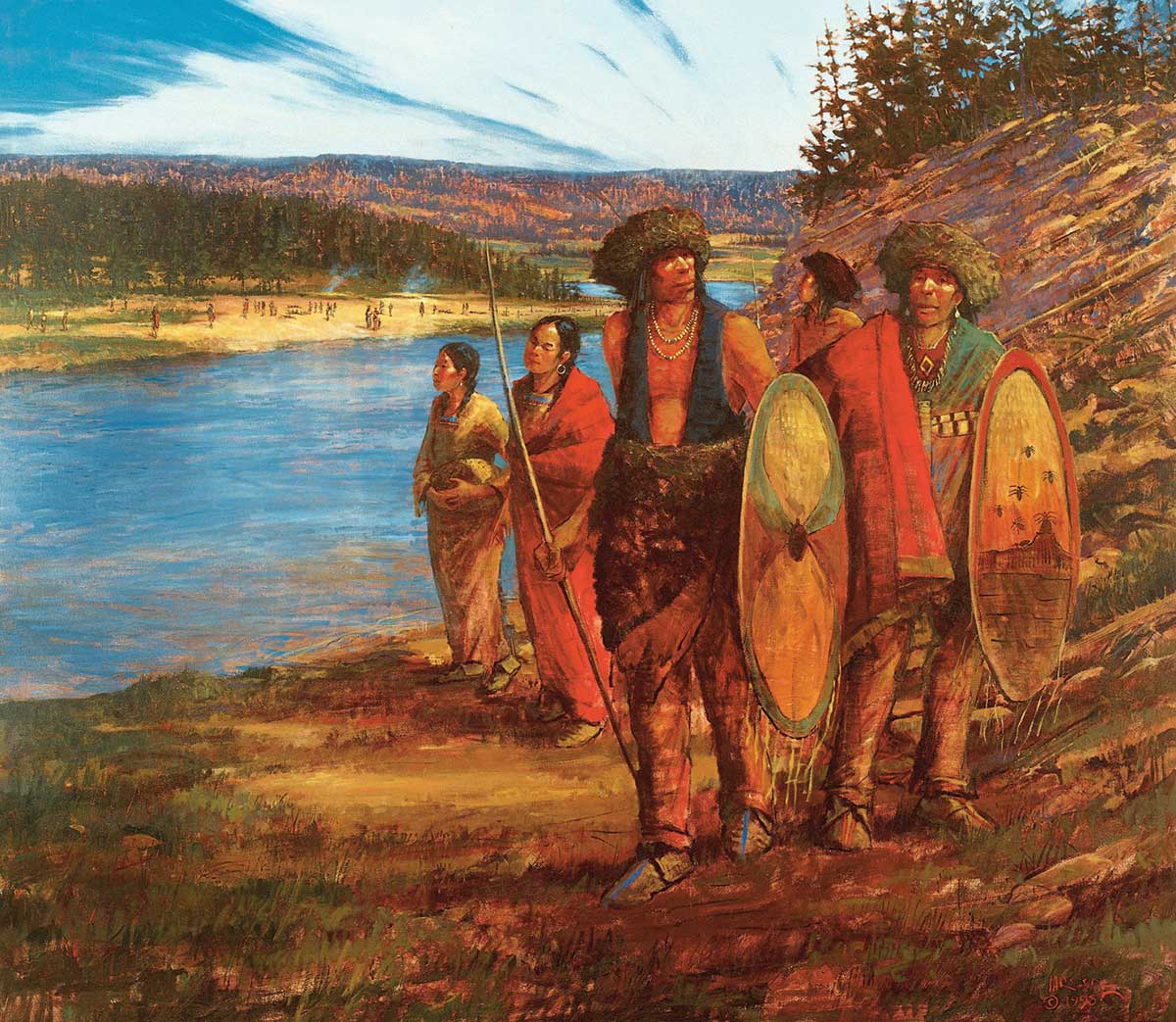
2. Mike Larsen
Quartz Mountain:
Sacred Ground—The Past
Down from the Yellowstone
1998
Acrylic on canvas
Gift of Richard W. Moore, Jr., in memory of his father, Richard W. Moore, Altus, Oklahoma
This painting depicts the Kiowa leaving their ancestral homeland near the headwaters of the Yellowstone River in western Montana. From here, the Kiowa migrated eastward to the Black Hills before finally settling on the Great Plains. Being attentive to historical detail, Larsen is careful not to include a horse, as the animal had not yet been introduced to the Kiowa at the time of their migration. Larsen’s detailed rendering of the clothing adds vitality to the work and is also historical in depiction.
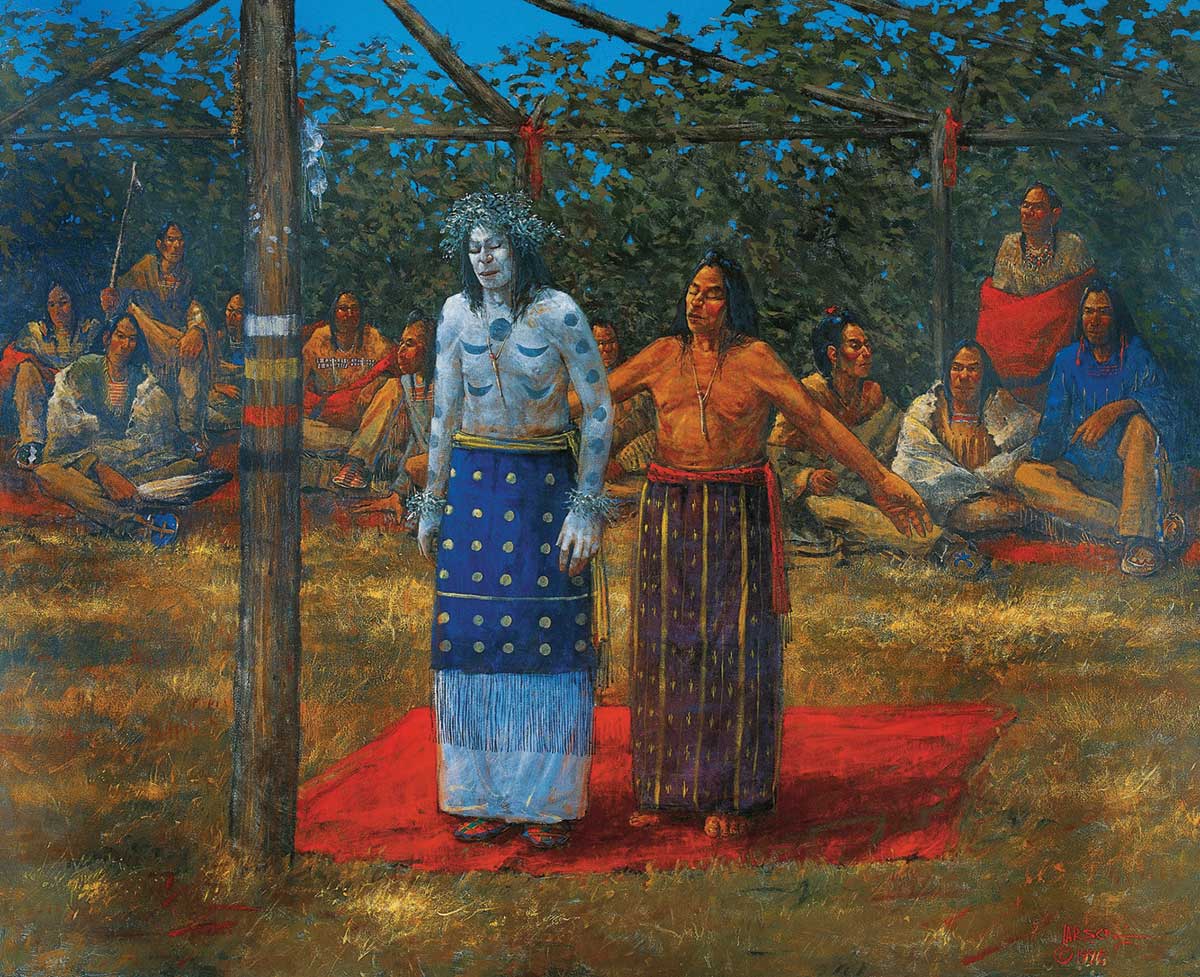
3. Mike Larsen
Quartz Mountain:
Sacred Ground—The Past
Kiowa Sundance
1998
Acrylic on canvas
Gift of Richard W. Moore, Jr., in honor of his mother Melda E. Moore, Altus, Oklahoma
The most sacred of Kiowa ceremonies, the Sundance, is said to have taken place at Quartz Mountain. In this painting, the Sundance “pledge” or participant stands inside a cottonwood arbor painted with white clay and Kiowa symbols. Larsen also includes other symbolic attributes in this work, such as the sage at the head and wrists of the pledge and the eagle bone whistles worn by both the pledge and the elder next to him.
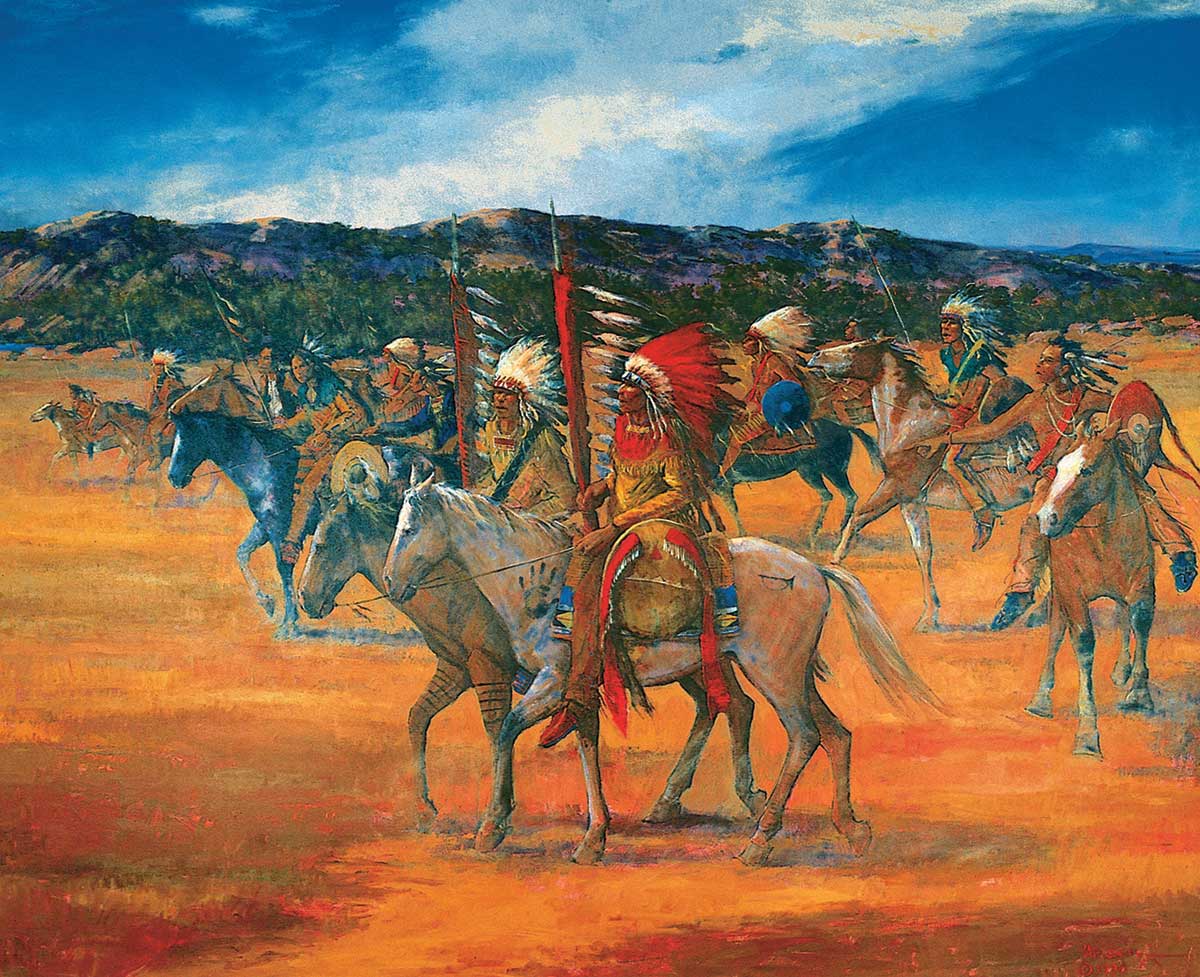
4. Mike Larsen
Quartz Mountain: Sacred Ground—The Past
Warriors of the Great Plains
1998
Acrylic on canvas
Gift of Ann Alspaugh, Oklahoma City, in honor of her pioneer family in Duncan, Oklahoma
At the center of this composition, Chief Satanta, or White Bear, leader of the Lone Wolf Clan, rides through the Quartz Mountain area with the Order of Ten Warriors. These renowned horsemen were comprised of Kiowa leaders from ten different clans, each of whom was responsible for carrying one of the ten sacred Kiowa medicine bundles.
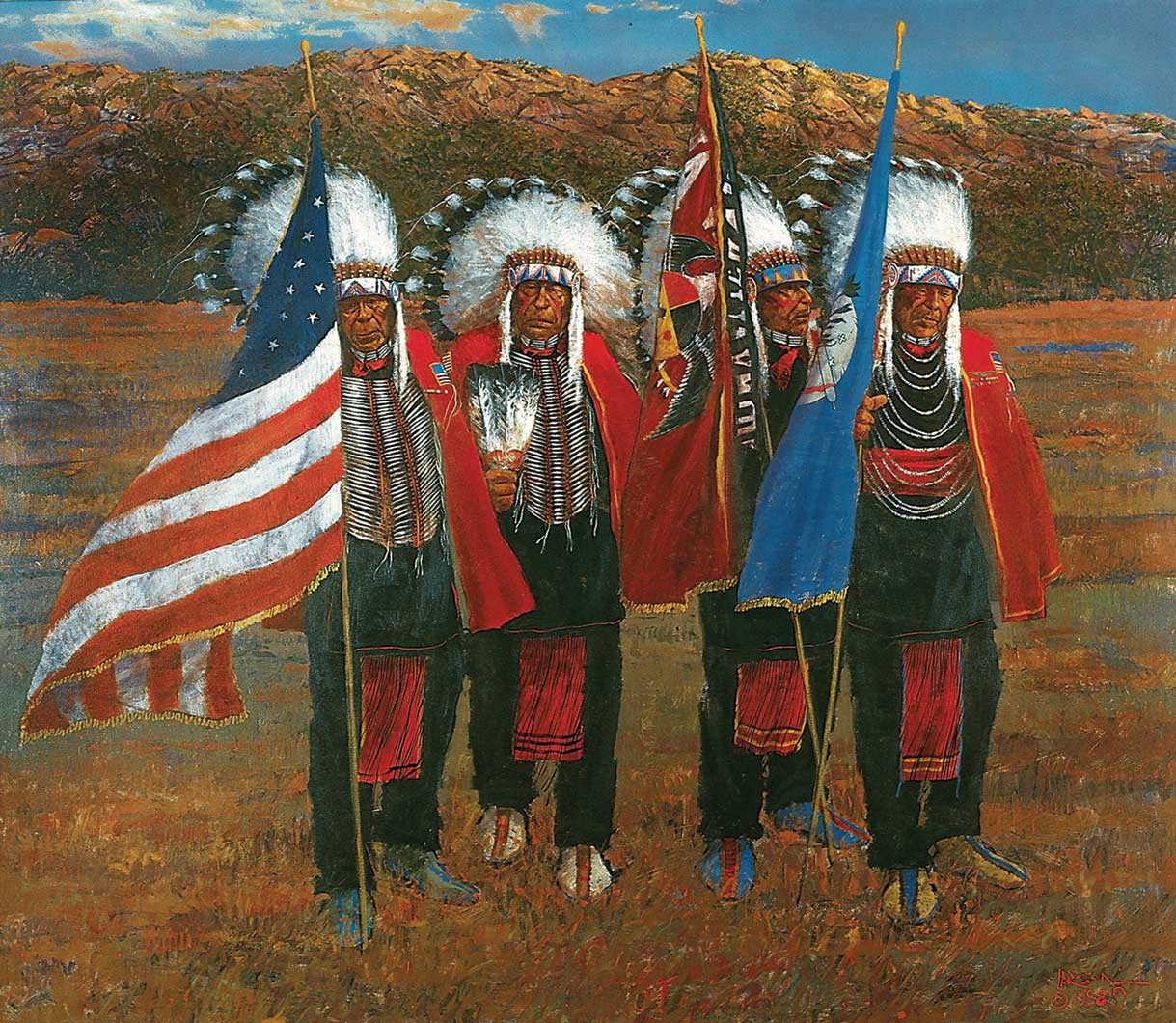
5. Mike Larsen
Quartz Mountain: Sacred Ground—The Past
Black Leggins Society
1998
Acrylic on canvas
Gift of Everett and Jean Berry, Stillwater, Oklahoma
In this work, Larsen portrays four members of the Kiowa Black Leggins Society, a group of Kiowa individuals who are veterans of World War II, the Korean War and the Vietnam War. The Kiowa elders who are the subject of this painting are members of the Palmer family of Carnegie, Oklahoma. Gus Palmer, Sr. revived this warrior society in 1957. Each year, the Black Leggins Society visits the Oklahoma Summer Arts Institute to present the colors in a ceremony prior to student performances.
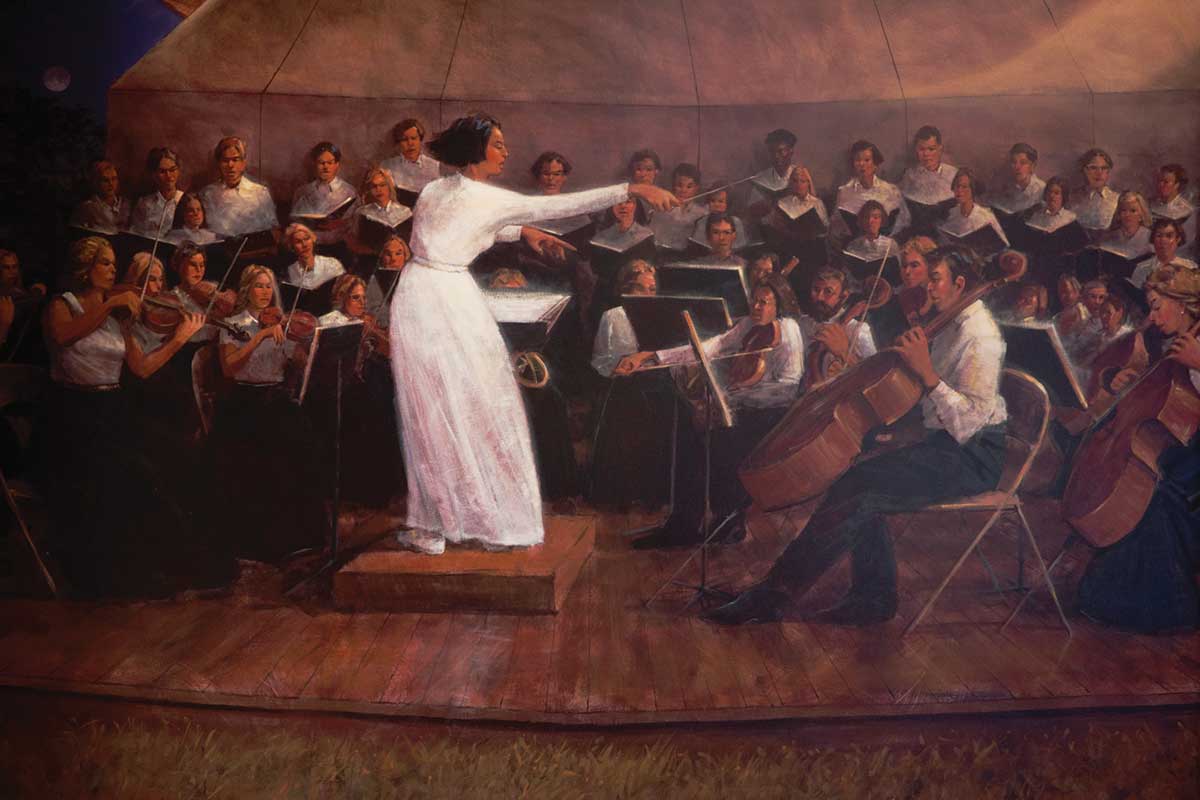
6. Mike Larsen
Quartz Mountain: Sacred Ground—The Future
Onstage with Judith Somogi
1999
Acrylic on canvas
Gift of Jerome Westheimer, Ardmore, Oklahoma, in honor of his family
This work depicts conductor Judith Somogi leading the Summer Arts Institute Orchestra when she taught in 1978. Somogi was considered America’s first great female conductor. Viewers are reminded of the exceptional music program available to Oklahoma’s high school students at Quartz Mountain.
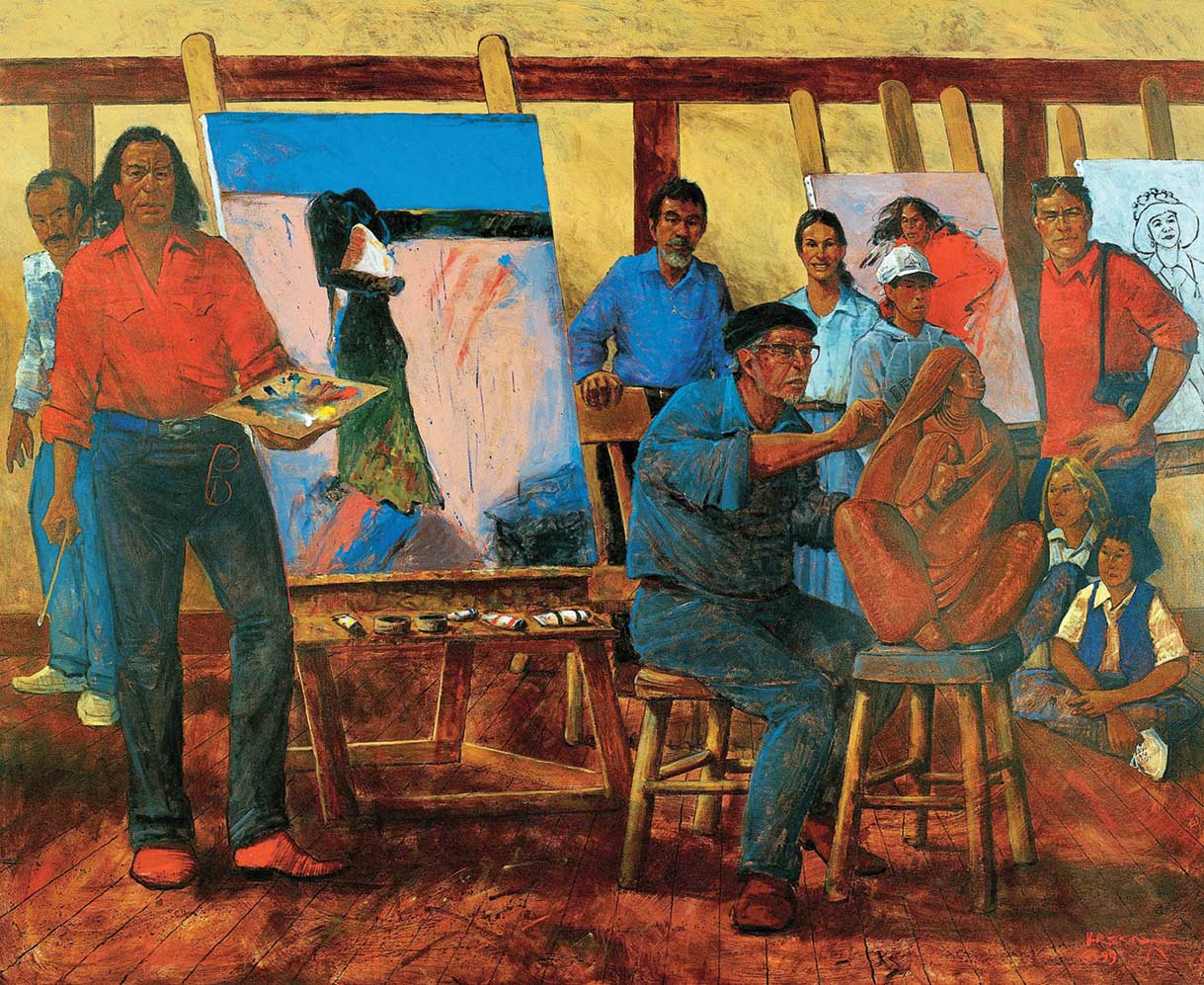
7. Mike Larsen
Quartz Mountain:
Sacred Ground—The Future American Masters
1999
Acrylic on canvas
Gift of Jerome Westheimer, Ardmore, Oklahoma, in honor of his family
A salute to the visual artists who have taught at Quartz Mountain, Larsen depicts painter Fritz Scholder and sculptor Allan Houser in the foreground with examples of their work. Oklahoma photographer David Fitzgerald stands in the background to the far right. Larsen places himself in the painting behind his close friend Houser, who had passed away several years earlier. Standing between Larsen and Fitzgerald are Mary Frates, founder and former President of the Oklahoma Arts Institute, with her son Cole. The Quartz Mountain Art Collection contains works by both Scholder and Houser, who also taught at the Summer Institute.
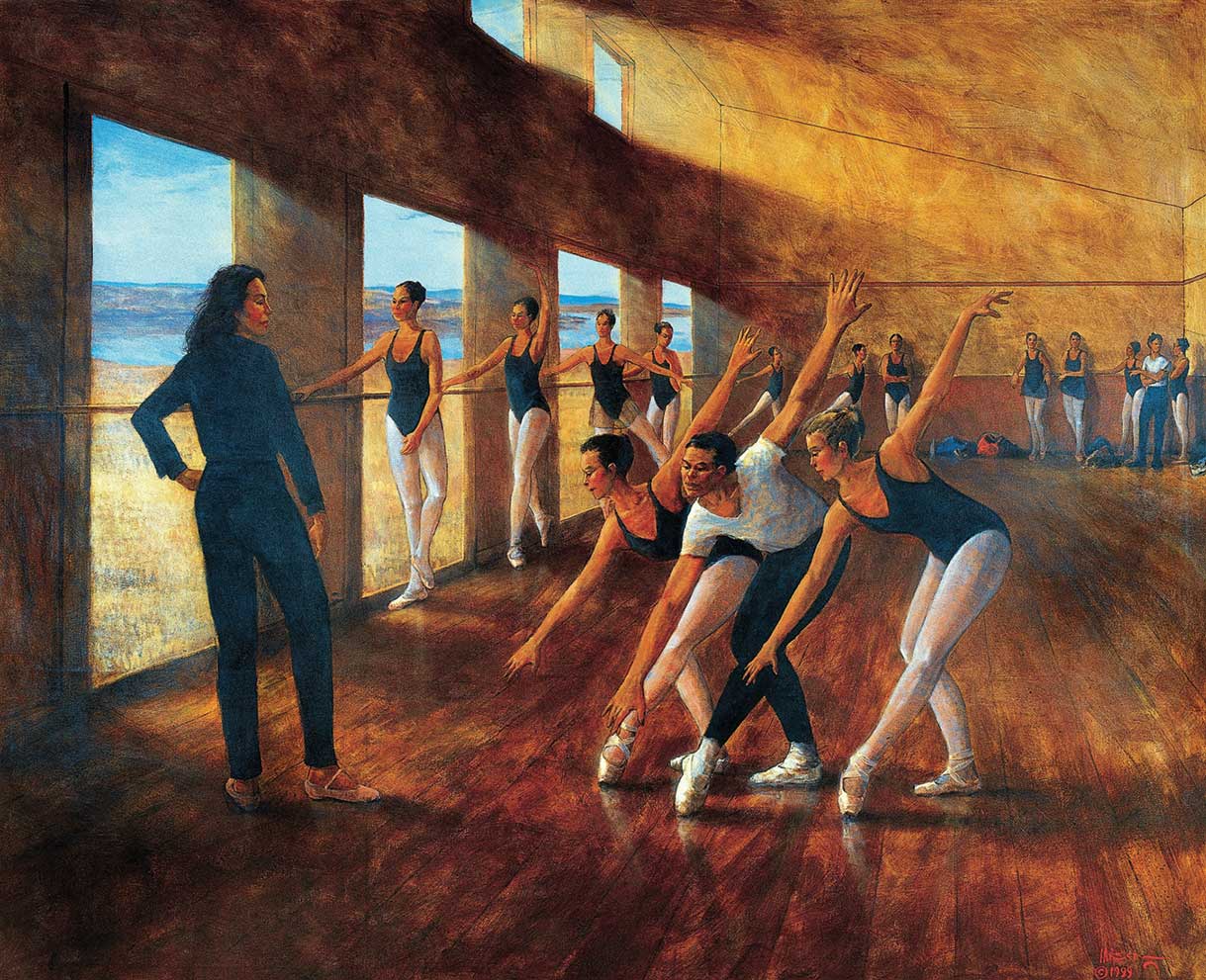
8. Mike Larsen
Quartz Mountain:
Sacred Ground—
The Future
In the Studio
1999
Acrylic on canvas
Gift of Jerome Westheimer, Ardmore, Oklahoma, in honor of his family
In this work, Larsen offers the viewer a peek into a dance class at the inaugural Oklahoma Summer Arts Institute, where students were taught by America’s first prima ballerina, Maria Tallchief. The painting depicts Tallchief leading a rehearsal of a ballet choreographed by her former husband, George Balanchine. By hiring exceptional faculty, such as Tallchief, its first year, the Arts Institute set a high standard that would become a hallmark of the program.
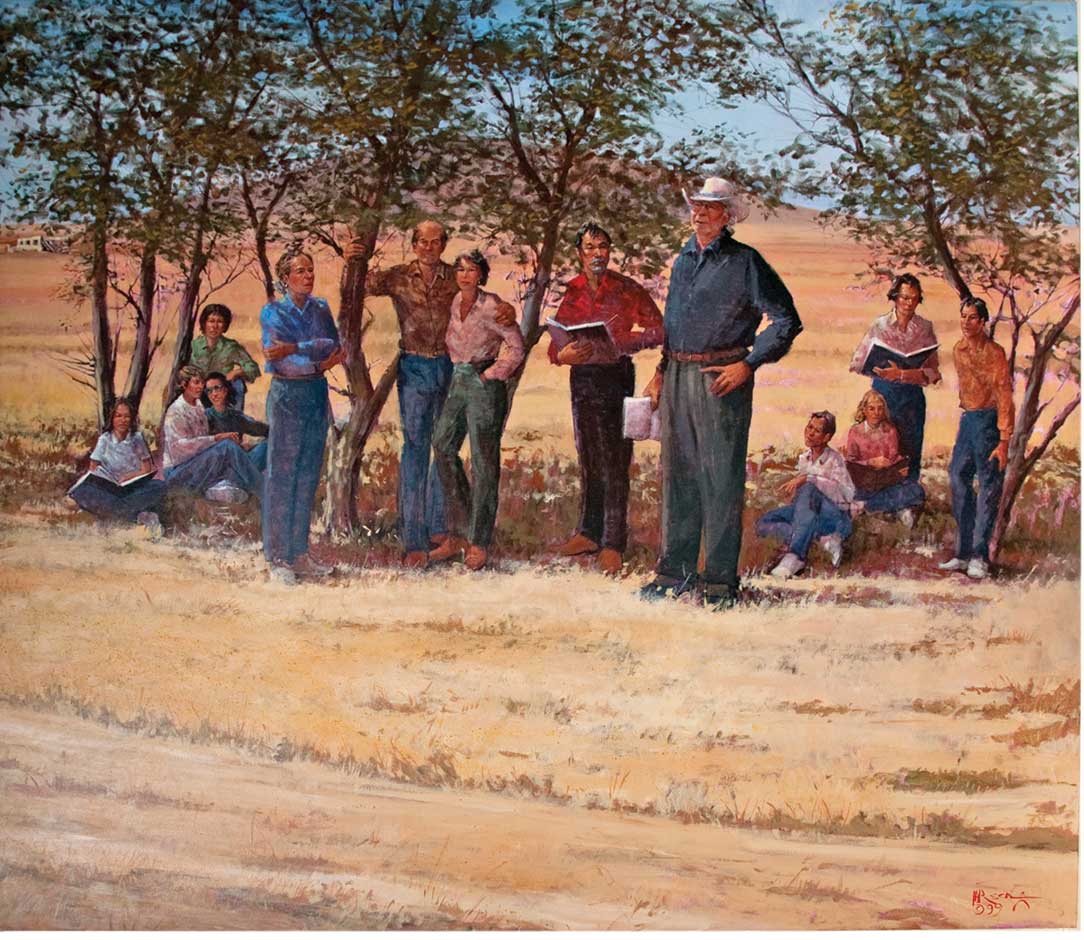
9. Mike Larsen
Quartz Mountain:
Sacred Ground—The Future
Visit to Rainy Mountain
1999
Acrylic on canvas
Gift of Jerome Westheimer, Ardmore, Oklahoma, in honor of his family
In this work, Larsen pays tribute to creative writing and theater by commemorating a visit to nearby Rainy Mountain during the Summer Arts Institute. The painting depicts acting instructors Jane Alexander and Ed Sherin, along with other faculty, staff and students, listening intently to poetry instructor N. Scott Momaday. A Pulitzer Prize winning Kiowa-Cherokee writer, Momaday wrote The Way to Rainy Mountain (1976), which details the history of the Kiowas, beginning in their ancestral Montana home and ending with their Great Plains resettlement near Rainy Mountain, located just east of Quartz Mountain.
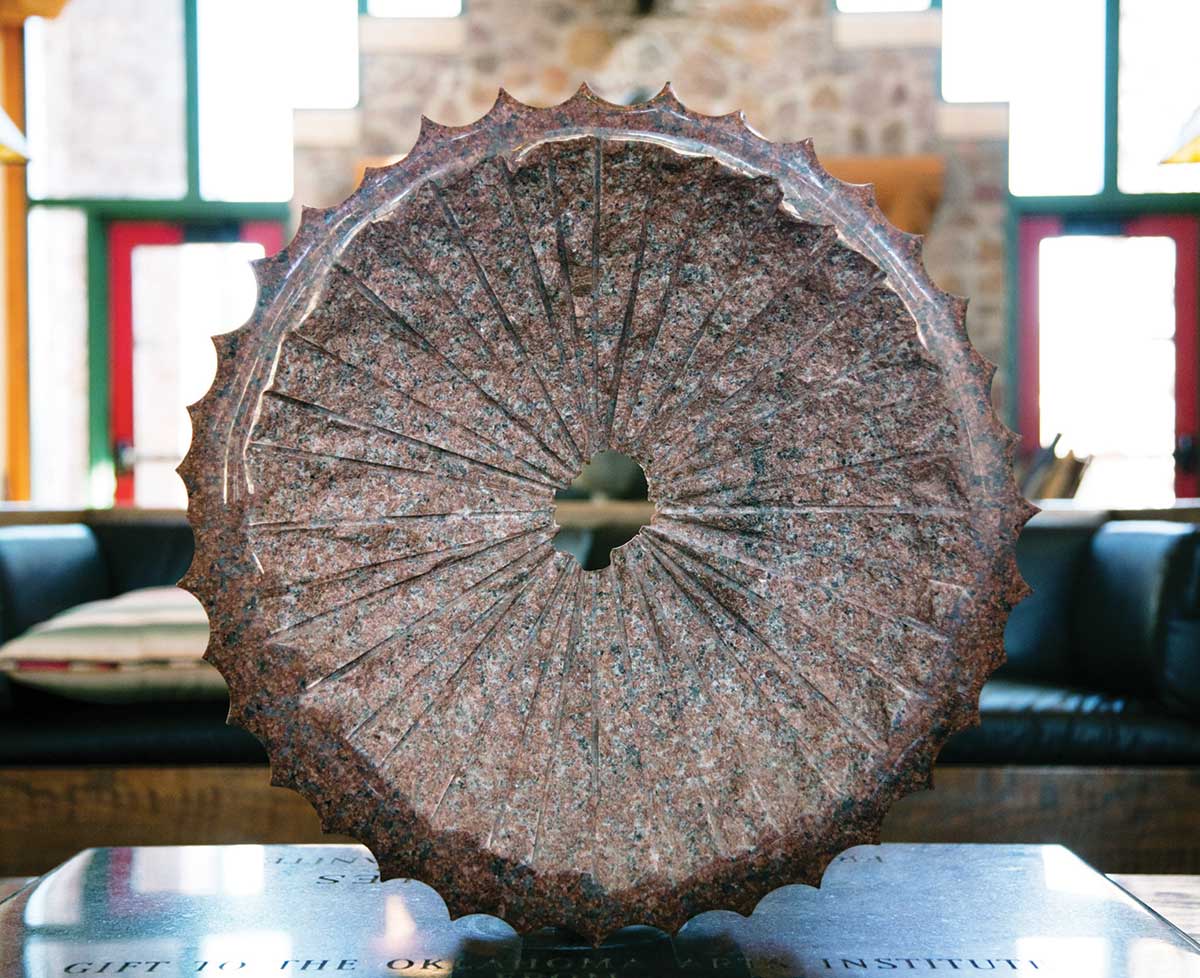
10. Jesús Moroles
Moonring
1999
Granite
Gift from David and Jeanne Guthery
in memory of Jean Hulsey Rumsey
A sculptor from Texas, Moroles is well-known for his large scale works in stone. With over 2,000 works in collections in the United States and abroad, Moroles has won international acclaim for his pieces. This work evidences a common process used by the artist called “tearing,” in which small holes are drilled in the stone and pressure is applied to wedges in the middle of the stone to create an opening. Moroles has taught numerous sculpture workshops at the Fall Arts Institute at Quartz Mountain.
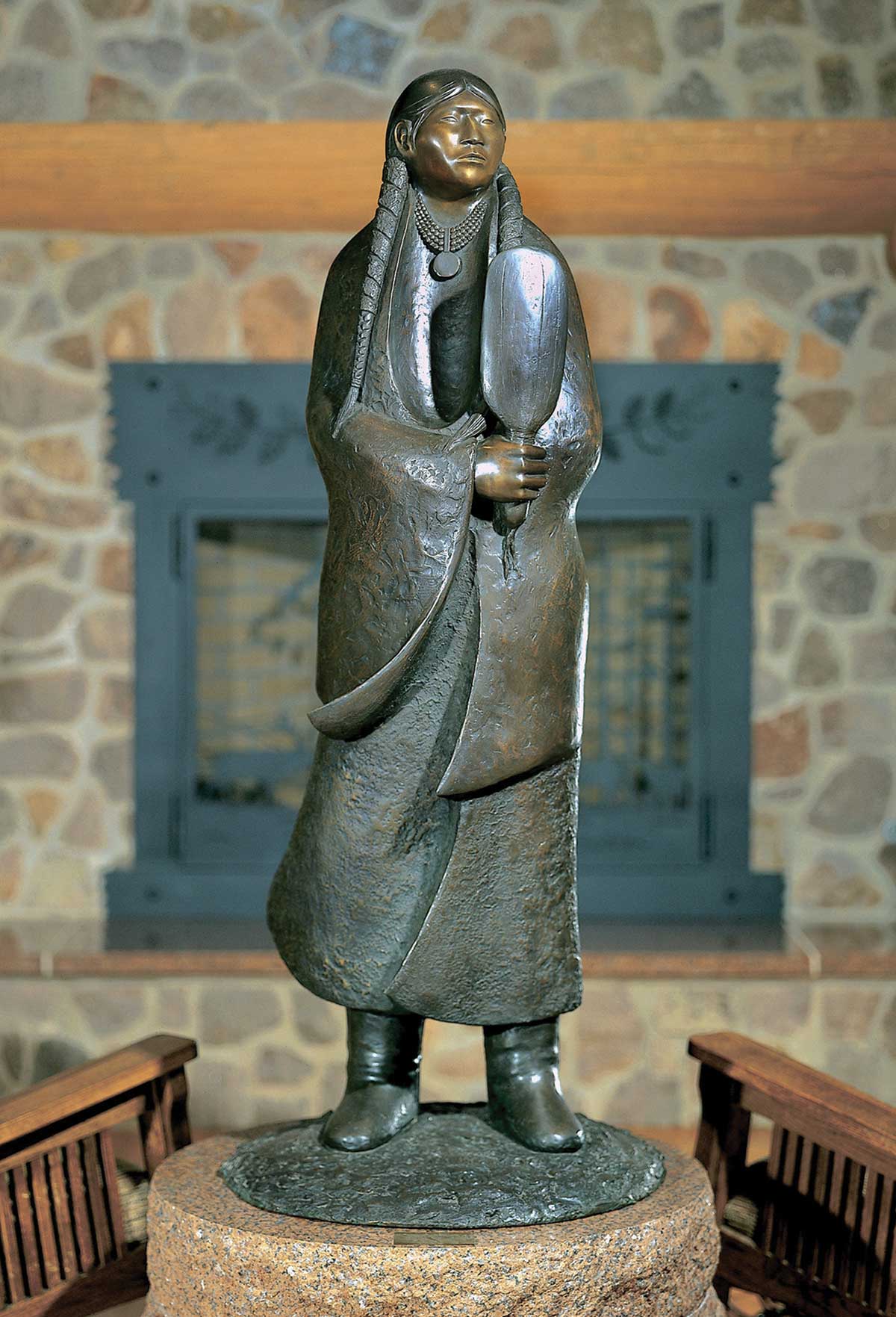
11. Allan Houser
As Long As the Waters Flow
1988
Bronze
Gift of Donald R. Brattain,
Minneapolis, Minnesota
Allan Houser, a Chiricahua Apache and Oklahoma native, has remained one of the nation’s most influential and respected Native American artists since his death in 1994. His work has received international acclaim and is included in the collections of the Smithsonian Institution, the Metropolitan Museum of Art, and the White House, among others. The title, “As Long As the Waters Flow,” refers to President Andrew Jackson’s promise that Native Americans would possess their land “as long as the grass grows or the water runs.” This work features a Native American woman in traditional attire, holding a sacred eagle feather fan. A larger version of this work is installed at the Oklahoma State Capitol. Houser was a guest artist at the Summer Arts Institute in 1989.
From the Lodge Lobby, turn left to proceed down the west hallway. The tour continues to your immediate left, behind the registration desk area.
